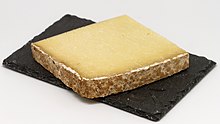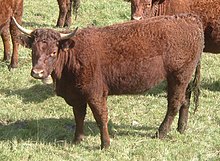Cantal (cheese)

Cantal , also known as Fourme de Cantal or Cantalet , is an old French raw milk cheese from Auvergne , which is made from the milk of Salers cattle . The product has been protected by an Appellation d'Origine Contrôlée (AOC) since 1956 , which was replaced by an Appellation d'Origine Protégée (AOP) in 1996 .
The cheeses Salers and Laguiole are related to the Cantal . The special feature is that the name of the cheese is also dependent on the season: cheese made from the milk of on mountain pastures is made grazing Salers cattle and produced between 15 April and 15 November, is allowed to Salers cheese name ; the cheese made out of season is called Cantal .
origin

The Cantal cheese comes from a limited area in the Auvergne with the Cantal department as the center and 8 communes in the north of the Aveyron department , 23 in the Puy-de-Dôme department , 7 in the Corrèze department and one commune in the Haute-Loire department . In these mountainous regions, the Salers cows give relatively little, but milk that contains fat . Cantal is considered one of the oldest cheeses in France - Pliny the Elder mentioned it almost 2000 years ago.
The Cantal was originally a raw milk cheese ; The pasteurization of milk was only invented in the second half of the 19th century and only applied across the board around the middle of the 20th century - today both types are produced and marketed, with the raw milk cheese being more by the farmers themselves ( Cantal fermier ) and small cooperatives organized cheese factories .
Manufacturing
A special feature is that the cheese is pressed twice: the curds that have already been pressed are crushed again. This repeated grinding of the tome (pressed disc) with the help of a grinder is a process that is only used in France for Cantal and its descendants. Then it is salted at 21 to 24 g per kilogram and pressed into its final shape. The dough is semi-firm and compact; it is not heated. The loaf has a diameter of 36 to 42 cm and a height of 35 to 40 cm. During the ripening process, the cheese is rubbed and turned twice a week. The fat content is around 45 g per 100 grams of dry matter.
Maturity levels
Up to one month of age, Cantal is offered as a jeune ; it is white in color and its consistency is reminiscent of other types of soft cheese, but it tastes significantly spicier. After a ripening period of two to six months, it is known as entre deux , and its color is golden yellow. The cheese with the name vieux , however, has matured for more than six months; it is then often reddish and somewhat cracked; its consistency and taste are then remotely comparable to parmesan .
The right wine
Cantal is considered a nutty and slightly acidic cheese. Its bark cracks easily, it is beige-gray, thin and dry. This promotes mold growth in the loaf. The perfect drink for the Cantal is a dry red wine (e.g. Rioja or Côtes d'Auvergne ).
literature
- André Dominé : Culinaria - French specialties. A culinary journey. Edited by Günter Beer. Könemann, Cologne 1998, ISBN 3-8290-1649-2 .
- Kazuko Masui: French cheese. 350 varieties from all regions of France (= Collection Rolf Heyne ). Edited by Randolph Hodgson. 3rd, updated and revised edition. Heyne, Munich 2000, ISBN 3-453-12886-9 .
- Judy Ridgway: Cheese. The manual for connoisseurs. Benedikt Taschen Verlag, Cologne 2000, ISBN 3-8228-6382-3 .

